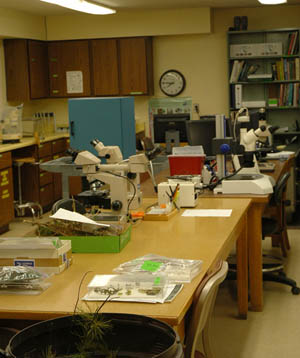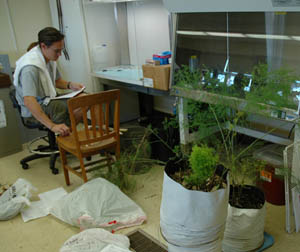2008 Plant Clinic Summary | |
|---|---|
| November 19, 2008 | |
|
Many clients ask for a summary of some of the major diseases we see at the University of Illinois Plant Clinic each year. I am happy to provide this information for 2008, but I stress that this information in no way represents a survey of diseases in Illinois. However, it probably represents some of the major concerns in the Illinois green industry, at least those that may need lab work for confirmation.  The Plant Clinic handles plant problems (diseases, insects, weeds, and other) not only on ornamental hosts but also on field crops and other plants as well. When I look at traditional Plant Clinic samples (excluding soybean rust samples and excluding agronomic phytosanitary-inspection samples) a few interesting facts emerge.  This season started slowly in the landscape and at the Plant Clinic. The cool, wet weather slowed the growth of plants, pathogens, and insects. The greatest number of samples arrived in July this year. Of the ornamental samples, more than 50% were submitted by the green industry. Samples definitely originated from more urban areas, with Champaign, Cook, DuPage, Lake, Madison, Peoria, Sangamon, and Vermilion counties leading in numbers submitted. Many of you are interested in tree problems, with 37% of clinic samples concerning deciduous woody ornamentals and 18% concerning evergreen woody ornamentals. Anthracnose was much more prevalent this year than past years. The reason is the weather. The anthracnose fungi prefer mild (less than 80°F) temperatures and leaf wetness. The wettest January to July on record in Illinois occurred in 2008. Mild temperatures lasted through July. Both allowed for repeated secondary spread of the anthracnose fungi in 2008. Dry weather usually halts the spread. Plant Clinic anthracnose samples ranged from hosta and watermelon to maple, oak, ash, birch, and hornbeam. Dothistroma on pine (especially Austrian and Ponderosa) was common in 2008. Again, this is related to the cool, wet conditions. Dothistroma continues to spread in cool, wet conditions from May through October. Rhizosphaera needle cast of spruce started appearing at the clinic in July and peaked in August and September. Because infection is prevalent in wet conditions and symptoms show 12 to 18 months later, expect more of this in 2009. Cedar–quince rust has been a chronic problem for at least the last 5 years, with 2008 being no exception. I saw it more in the landscape than in the Plant Clinic, so maybe growers are getting better at identifying this disease. Galls can be caused by many problems. We saw bacterial galls from crown gall on euonymus. We also found fungal galls of Phomopsis on forsythia, pine gall rust on pine, cedar–apple and related rusts on cedar and hawthorn, and black knot on plum. We also found gouty oak gall caused by insects and ash flower galls caused by eriophyid mites. Honeylocust “knots” were again found in Illinois, but the cause is still undetermined. Oak wilt was discussed in issue no. 16 of this newsletter. We found 12 positive cases of oak wilt in Illinois, with a total of 45 samples assayed. Please remember that vascular streaking of the wood is essential to a positive isolation. In addition, samples must be sent on disposable ice packs to keep from heating up in the mail. Dutch elm disease is still present in Illinois. Of 33 samples assayed, 13 were positive this year. Verticillium wilt was especially common in 2008. The fungus lives in the soil and is favored by moist conditions. Additionally, stressed trees show increased susceptibility. Refer to issue no. 17 for details on 2008 isolations. Bacterial leaf scorch was confirmed in 7 oaks this year. Read the details in issue no. 19 of this newsletter. Keep in mind that we have confirmed this bacterial disease from JoDaviess County in far northern Illinois to Jefferson County in the south. So far, the Plant Clinic has confirmed it only on oaks. Watch for scorch symptoms that spread within a tree and in intensity from year to year on elm, hackberry, maple, mulberry, sweetgum, and sycamore. Recently, I presented a talk entitled “Woody Plant Disease Update for 2008” at the 2008 Illinois Arborists Association Meetings. A pdf of that PowerPoint presentation will be available on the Plant Clinic Web page soon. Although there is no text on the pdf, images of many of the diseases discussed here can be found on that pdf. Feel free to access it at http://plantclinic.cropsci.uiuc.edu/. | |
| Author: | Nancy Pataky |
